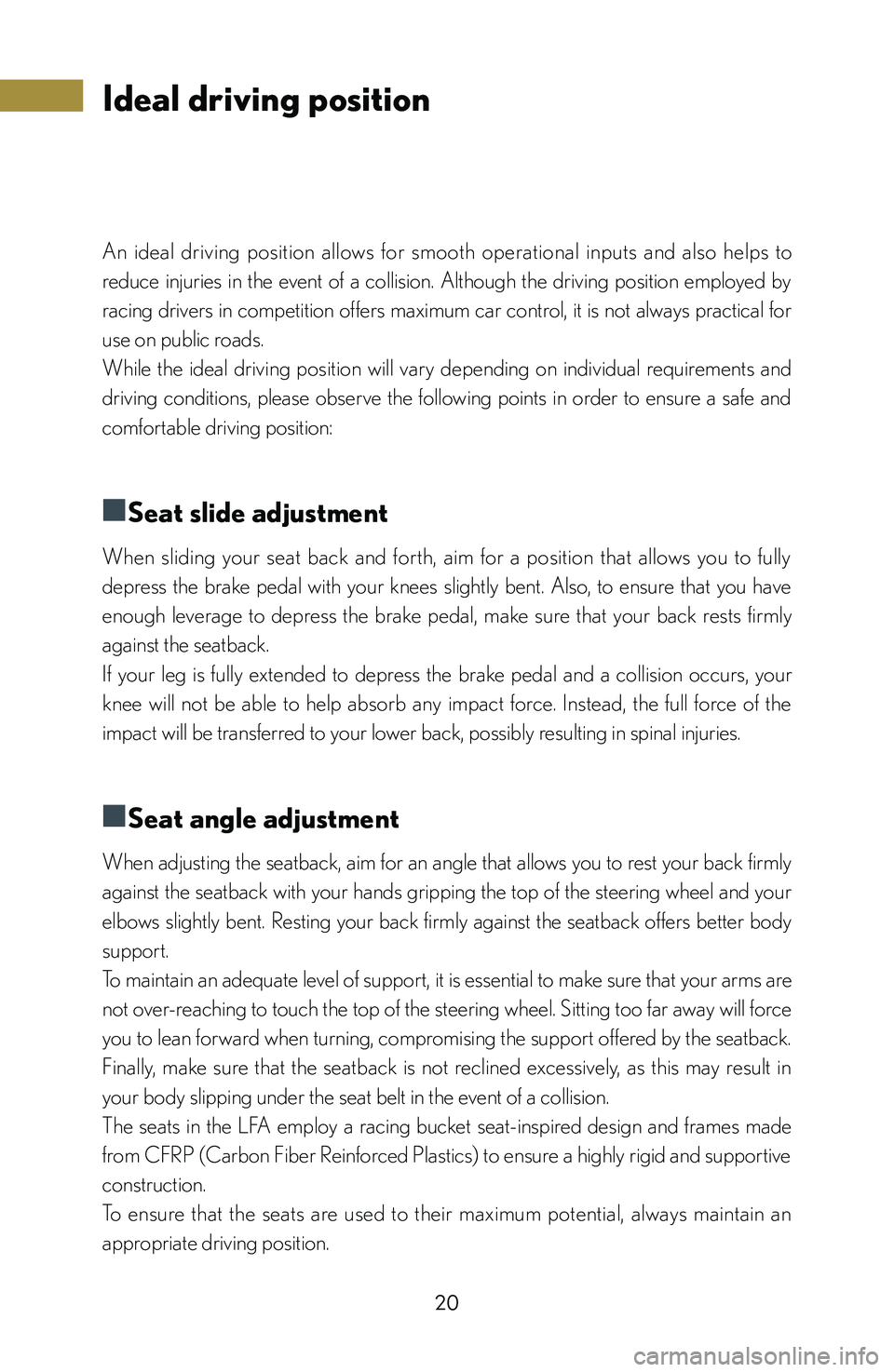Page 22 of 128

20
Ideal driving position
An ideal driving position allows for smooth operational inputs and also helps to
reduce injuries in the event of a collision. Although the driving position employed by
racing drivers in competition offers maximum car control, it is not always practical for
use on public roads.
While the ideal driving position will vary depending on individual requirements and
driving conditions, please observe the following points in order to ensure a safe and
comfortable driving position:
■
■Seat slide adjustment
When sliding your seat back and forth, aim for a position that allows you to fully
depress the brake pedal with your knees slightly bent. Also, to ensure that you have
enough leverage to depress the brake pedal, make sure that your back rests firmly
against the seatback.
If your leg is fully extended to depress the brake pedal and a collision occurs, your
knee will not be able to help absorb any impact force. Instead, the full force of the
impact will be transferred to your lower back, possibly resulting in spinal injuries.
■
■Seat angle adjustment
When adjusting the seatback, aim for an angle that allows you to rest your back firmly
against the seatback with your hands gripping the top of the steering wheel and your
elbows slightly bent. Resting your back firmly against the seatback offers better body
support.
To maintain an adequate level of support, it is essential to make sure that your arms are
not over-reaching to touch the top of the steering wheel. Sitting too far away will force
you to lean forward when turning, compromising the support offered by the seatback.
Finally, make sure that the seatback is not reclined excessively, as this may result in
your body slipping under the seat belt in the event of a collision.
The seats in the LFA employ a racing bucket seat-inspired design and frames made
from CFRP (Carbon Fiber Reinforced Plastics) to ensure a highly rigid and supportive
construction.
To ensure that the seats are used to their maximum potential, always maintain an
appropriate driving position.
Page 98 of 128
96
■
■Manually releasing the parking brake
Apply wheel chocks before manually releasing the parking brake.
1 Open the rear hatch and remove the
cover.
M a n u a l l y u n l o c k i n g t h e r e a r h a t c h
(
" P. 95)
2 Release the belt and take out the tool
bag.
Take the parking brake release tool and the
screwdriver handle out of the tool bag.
Page 103 of 128
101
When transporting the vehicle
2 Release the belt and take out the tool
bag.
Ta ke t h e t ow i n g e ye l e t a n d f l a t h e a d
screwdriver.
3 Re m ove t h e e ye l e t c ove r u s i n g a
flathead screwdriver.
To protect the bodywork, place a rag between
the screwdriver and the vehicle body, as shown
in the illustration.
4 Insert the towing eyelet into the hole
and tighten partially by hand.
5 Completely lower the transport vehicle’s flatbed and attach its cable to the towing
eyelet.
6 Slowly wind up the transport vehicle’s
cable, being careful to avoid contact
between the LFA and the flatbed.
Use additional ramps if necessary.
Page 104 of 128
102
7 Select Neutral, engage the parking
brake, and turn the ignition switch to
the “LOCK” position.
8 When the LFA is completely loaded
onto the transport vehicle, secure it
with tire belts and chocks.
Be careful not to damage the tires with the
edge of the chocks.
Disabling the tilt sensor
If the tilt sensor is left on when loading the LFA onto a transport vehicle, the auto
alarm may activate.
1 Stop the engine and remove the
key.
2 Press the tilt sensor cancel switch
located inside the glove box.
3 While the indicator is flashing faster
than normal, close all the doors and
lock the vehicle using the wireless
remote control.